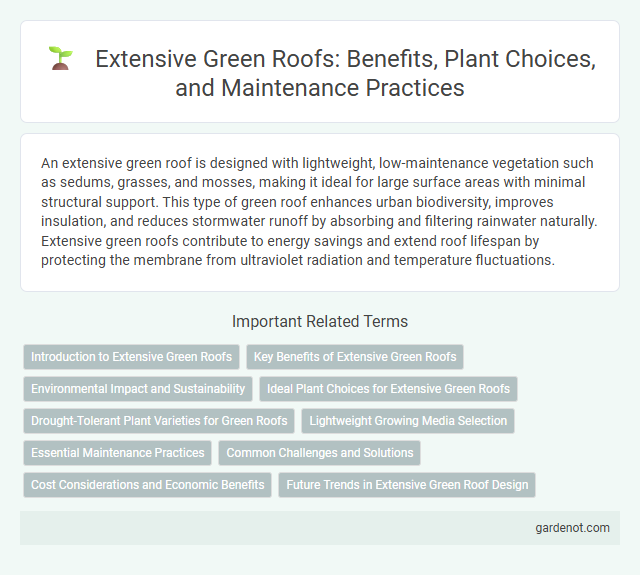An extensive green roof is designed with lightweight, low-maintenance vegetation such as sedums, grasses, and mosses, making it ideal for large surface areas with minimal structural support. This type of green roof enhances urban biodiversity, improves insulation, and reduces stormwater runoff by absorbing and filtering rainwater naturally. Extensive green roofs contribute to energy savings and extend roof lifespan by protecting the membrane from ultraviolet radiation and temperature fluctuations.
Introduction to Extensive Green Roofs
Extensive green roofs typically consist of lightweight, low-maintenance vegetation such as sedums, mosses, and grasses, designed for minimal irrigation and shallow substrate layers ranging from 2 to 6 inches. These roofs enhance urban biodiversity, improve stormwater management by retaining up to 50-70% of rainfall, and provide thermal insulation that reduces energy costs. Installation on structures with load-bearing capacities around 15-50 pounds per square foot makes extensive green roofs ideal for residential and commercial buildings seeking sustainable roofing solutions.
Key Benefits of Extensive Green Roofs
Extensive green roofs offer significant environmental benefits, including enhanced stormwater management by reducing runoff and improving water retention. Their lightweight design supports low-maintenance vegetation such as sedums, which contributes to urban biodiversity and temperature regulation by mitigating the urban heat island effect. These roofs also extend building lifespan by protecting roofing materials from UV radiation and thermal fluctuations.
Environmental Impact and Sustainability
Extensive green roofs significantly reduce urban heat islands by improving insulation and lowering roof surface temperatures, which leads to decreased energy consumption. They enhance rainwater management by absorbing and filtering stormwater, reducing runoff and mitigating flood risks. Utilizing drought-resistant plants and lightweight substrates, extensive roofs offer sustainable, low-maintenance solutions for improving biodiversity and air quality in urban areas.
Ideal Plant Choices for Extensive Green Roofs
Ideal plant choices for extensive green roofs include drought-resistant sedums, native grasses, and low-maintenance succulents, which thrive in shallow substrates and require minimal irrigation. These species enhance biodiversity, improve insulation, and reduce stormwater runoff while maintaining lightweight and low-maintenance characteristics essential for extensive roof systems. Selecting plants adapted to local climate conditions ensures long-term sustainability and performance of the green roof.
Drought-Tolerant Plant Varieties for Green Roofs
Extensive green roofs thrive with drought-tolerant plant varieties such as Sedum, Sempervivum, and Delosperma, which require minimal irrigation and maintenance. These succulent species enhance water retention and reduce runoff while withstanding prolonged dry periods. Selecting native, drought-resistant flora further supports biodiversity and resilience in extensive green roof ecosystems.
Lightweight Growing Media Selection
Extensive green roofs require lightweight growing media with low bulk density, typically ranging from 800 to 1200 kg/m3, to minimize structural load. Selecting substrates composed of materials like expanded shale, pumice, or lightweight volcanic rock enhances drainage while sustaining adequate water retention for drought-tolerant vegetation. Incorporating organic components under 20% by volume ensures nutrient availability without compromising the media's lightweight properties essential for extensive roof applications.
Essential Maintenance Practices
Extensive green roofs require regular inspection of irrigation systems and drainage to prevent waterlogging and structural damage. Essential maintenance includes removing debris and dead plant material to promote healthy vegetation growth and enhance system longevity. Monitoring substrate moisture levels ensures optimal plant health and reduces the risk of drought stress.
Common Challenges and Solutions
Extensive green roofs often face challenges such as limited substrate depth, which restricts plant diversity and water retention capacity, leading to drought stress. Solutions include selecting drought-tolerant, low-maintenance plant species like sedum and optimizing irrigation systems that conserve water while sustaining vegetation. Regular maintenance practices, including substrate monitoring and erosion control, help prolong the roof's lifespan and ecological benefits.
Cost Considerations and Economic Benefits
Extensive green roofs typically cost between $10 to $25 per square foot, making them a more affordable option compared to intensive green roofs. They reduce stormwater runoff and lower energy bills by improving insulation, contributing to substantial long-term savings. Incentives such as tax credits and grants further enhance the economic benefits of installing extensive green roofs.
Future Trends in Extensive Green Roof Design
Extensive green roof design is evolving with advanced drought-resistant sedum species and lightweight growing media to enhance sustainability and reduce maintenance. Integration of smart irrigation systems and real-time soil moisture sensors optimizes water use, supporting eco-friendly urban environments. Future trends emphasize biodiversity through native plant incorporation and modular systems for easy installation and scalability in urban settings.
Extensive roof Infographic

 gardenot.com
gardenot.com